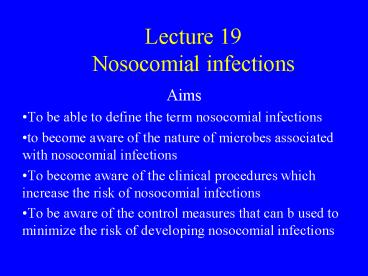Lecture 19 Nosocomial infections - PowerPoint PPT Presentation
1 / 20
Title:
Lecture 19 Nosocomial infections
Description:
to become aware of the nature of microbes associated with nosocomial infections ... Why do nosocomial infections occur? Question is complex ... – PowerPoint PPT presentation
Number of Views:1443
Avg rating:3.0/5.0
Title: Lecture 19 Nosocomial infections
1
Lecture 19Nosocomial infections
- Aims
- To be able to define the term nosocomial
infections - to become aware of the nature of microbes
associated with nosocomial infections - To become aware of the clinical procedures which
increase the risk of nosocomial infections - To be aware of the control measures that can b
used to minimize the risk of developing
nosocomial infections
2
Nosocomial infections
- In the US about 5 of patients develop an
infection in hospital even though they entered
hospital without an infection
3
Nosocomial infections defined
- Generally a nosocomial infection may be defined
as - An infection arising in patient (usually at least
48 post admission) that was not present or
incubating on admission - It may include infections post discharge if the
infection started whilst the patient was admitted
4
Nosocomial infections 1
- Characteristics
- many infections are endogenous in nature
- some exogenous infectious agent may only occur in
the healthcare setting (exceptions occur)
5
Infectious disease control
- Microbes mainly found in hospitals
- 3 main groups
- MRSA
- GRGNs
- GN endotoxaemia (/- associated with GRGN)
6
MRSA
- Multi (Methicillin) resistant S.aureus
- MRSA is endemic in many Australian hospitals
- The treatment of choice for S.aureus is
fluclocxacillin (methicillin) - MRSA is sensitive essentially only to (with few
exceptions) vancomycin - Alternative drugs are generally not recommended
unless excepional circumstances
7
MRSA
- MRSA in terms of pathogenicity is generally
regarded the same as S.aureus - MRSA can be associated with seriius infections
in - orthopaedic patients
- lung infections in ICU patients
- ss wound infections
8
MRSA
- Infections can be transmitted from carriers
- Includes health care professions and previously
colonized patients - may transiently colonize the nares, groin and
axillae - Recent reports indicate that MRSA has been
detected in some WA and NT aboriginal
communities- epidemiology not fully understood
9
MRSA
- Patients being transferred between health care
institutions should be screened for
MRSA(Methicillin MSA plate) - Patients known to be colonized with MRSA should
receive prophylactic vancomycin if undergoing
surgery - VRE has been reported and some suggestion that
VRSA is known overseas
10
Gentamicin Resistant Gram negative bacteria
- GRGNs may arise due to the extensive use of
gentamicin for the treatment of G-e infections - Includes bacteria which which may display
multiresistance eg to betalactams such as the
cephalosporins - eg Pseudomonas sp
- Enterobacter sp
- Acinetobacter sp
11
GRGNs
- Can be screened for eg faecal swab on Gentamicin
containing plates - GRGNs are not as prevalent in Australian
hospitals, but are becoming an increasing problem - Can cause severe and difficult to treat
infections in compromised hosts eg - Burns patients
- Para/quadraplaegic patients
- long term ICU patients
12
Gram negative sepsis leading to endotoxamia
- This is an emerging problem for ICU patients on
parenteral feeding - Seems that without bulk feeding that the gut may
become leaky to endotoxins or GN bacteria -gt
endotoxaemia - poor prognosis (death rate 20-80)
- bacteria may also derive from prior lung, GI or
UTI/genital tract infection
13
Endotoxaemia
- E.coli is by far the greatest cause (gt80)
- other enteric gram negative bacteria include
- Enterobacter sp
- Klebsiella sp
- Proteus sp
- may also include Pseudomonas sp
- P.aeruginosa
- P.cepacia
14
Why do nosocomial infections occur?
- Question is complex
- The patients are compromised in some way
- We may have to interfere with the patients
immunity (non specific and specific) - We may expose sterile sites to endogenous
/exogenous bacteria - Exogenous bacteria (including a/b resistant
forms) are present in the environment on on
health care providers
15
Specific procedures that increase the risk of NIs
and their control measures
- Central and venous cannulation
- Risk Factors
- duration of cannulation
- catheters are readily colonized by bacteria
proximate to the site - Staphlococci
- Streptococci
- G-e bacteria if proximate to the groin
16
Central and venous cannulation
- Control measures
- Choice of site and device
- central v peripheral
- arm v groin
- Care during insertion (minimize trauma)
- Aseptic method
- maintaining hygiene (surveillance)
- phlebitis, cellulitis
- Reduce duration ASAP
17
Urinary catheters
- Risk factors
- Provides a common route for ascending infection
- Mainly G- bacteria (staphs and streps can be
involved) - Main G-e bacteria include
- E.coli, Proteus sp., Klebsiella sp Psuedomonads
- Bacteraemia may occur even at times if the
patient appears asymptomatic - The longer the catheter is in place the more
inevitable a UTI seems
18
Urinary catheters
- Control
- Aseptic and no traumatic insertion
- Appropriate choice of catheter
- Closed rater than open bag systems
- Good site hygiene
- Removal of catheter ASAP
19
Intubation
- Risk factors
- Intubation bypasses the respiratory mucous
escalator - Long term intubation is often associated with a
progression from lung infection with initially G
bacteria to G- to resistant Gram negative - Risks are increased as these patients are usually
cannulated as well (IV, UT)
20
Intubation
- Control Measures
- Surveillance is essential-
- pyrexia hypotension cloudy urine bags
- Microbiological monitoring eg B/C, urine
- Removal of devices ASAP
- Maintenance of devices
- Level of isolation commensurate with risk
- Nasogastric feeding v parenteral
- Review of antibiotic regimen































